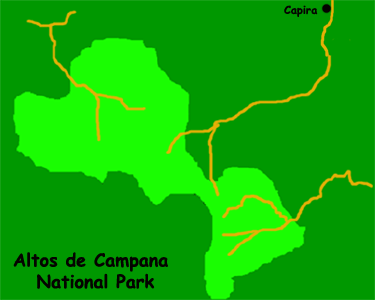

 |
|
The Altos de Campana National Park is 50 kilometers from Panama City, in the Province of Panama, on Chame Bay on the Pacific coast. It was the first National Park established in Panama, back in 1966. It is about one and a half hours drive from Panama City. The road from Panama City runs parallel to the coast. You pass through the towns of La Chorrera and Capira. A few kilometers after passing these towns, a side road takes up up to the park.
The park has an administrative office and a marked nature trail, from which you can observe lots of the park's animals. An illustrated guide of the park is available from the administrative office.
The area covered by the park is 4,925 hectares. Temperatures here hover around 24º C and rainfall exceeds 2,500mm per year (100 inches per year)
This area is part of the igneous rocks of El Valle de Anton volcano. Volcanic activity from the past can be seen in the cliffs, lava fields, and volcanic rocks that pepper the park. The park rises from 400 meters from its lowest point up to 850 meters above sea level in its highest point in Campana. From the high points there are great views over the canal basin and the mangroves at the at the mouth of the Chame River at Chame Point.
It was intended that the park should protect the hydrographic basins of the River Sajalices that flows towards the Pacific Ocean and the Ciri and Trinidad rivers that join the Chagres river.
There are four different types of terrain - humid tropical forest, very humid premotane forest, very humid tropical forest and premontane rainforest. The last census showed 198 species of trees and 342 species of bushes. Mosses, orchids, bromeliads and epiphytes multiply everywhere. There are 26 species of vascular plants. The park's endemic species include Chione campanensis. Studies have been carried out by Prof. Mireya D. Correa, professor at the University of Panama and researcher at the Smithsonian Tropical Research Institute. The latest listings include 1216 species of higher plants.
This park has been studied since the 1960's, when Florida State University established a camp here. There are 39 species of mammals, 267 species of birds of which 48 are migrating birds, 62 species of amphibians and 86 species of reptiles.
There are 39 mammal species, one of the most numerous being the black-eared opossum (Didelphis marsupialis). Also to be found are the endemic mouse species Liomys adspersus coati (Nasua narica), crab-eating raccoon (Procyon cancrivorus), two-toed sloth (Choloepus hoffmani) and three-toed sloth (Bradypus variegates), Geoffroy's tamarin (Saguinus geoffroyi).
The park's 62 species of amphibians and 86 kind of reptiles cover an extraordinary diverse number of species. The species that are exclusively native to this park include the rare frog Atelopus Zeteki or Golden Frog, which is found in a very small remote area of the national park. The others are the salamander Bolitoglossa schizadactyla, the caecilian (Caecilia volcani), gecko Anolis lionotus, lizard Morunasaurus grai, and the snakes Trimetopon barbouri and g. Winia, which have not yet been described. The protected area is also home to the giant frog Leptodactylus pentadactylus, the largest amphibian in Panama, the spiny toad (Bufo coniferus) and the poisonous frogs Dendrobates minutus and Dendrobates autatus
Birds here include the spectacular trogons, the orange-bellied trogon (Trogon auratiiventris) are found in numbers. The forests are also home to a number of species of birds that are threatened in other parts on America - for example sicklebill white-tipped (Eutoxeres aquila), the violet-bellied hummingbird (Damophila Julie panamensis)and the bronze-tailed plumelesteer (Chalybura urochrysia). You will also find here the common vampire. Migratory birds include the kite Elanoides forficatus, whose continental migrations take place between January and February and between June and September, when large numbers migrate via Panama.
There are hotels located near the park.